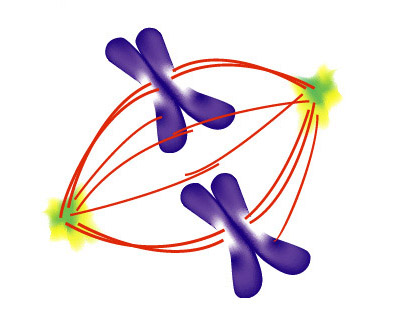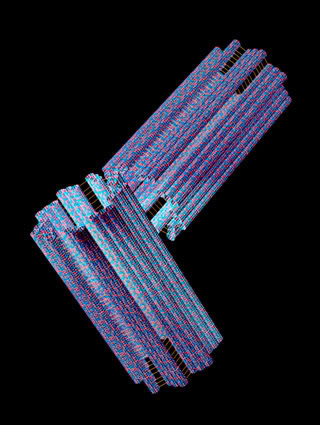| A | B |
|---|
| T or F: The larger a cell becomes, the more demands the cell places on its DNA.t | True |
| T or F: As a cell becomes larger, the cell has more trouble moving through nutrients and wastes across the cell membrane. | True |
| T or F: If a cell were to grow without limit, an information crisis would occur because DNA would not be able to handle the size. | True - the DNA would not make extra copies of DNA to accomodate the larger size |
| T or F: The rate of the exchange of prducts going into the cell and out of the cell depends on the surface area of the celll. | True |
| T or F: The surface area of the cell is the total area of the cell membrfane | True |
| T or F: The volume of a cell increases more rapidly than the surface area of the cell | True. This casues the ratio of the surface are to volume to decrease and this decrease creates serious problems for the cell |
| Cell Division | The process by which a cell divides into two new daughter cells |
| T or F: Before a cell divides, it replicates all of its DNA | True |
| T or F: Cell division solves the problem of increasing size by reducing cell volume | True because each daughter cell has an increased ratio of surface area to volume which allows for an efficient exchange of materials with the environment |
| Define Daughter Cells | When one cell, Mother Cell, l divides, it becomes two genetically identical cells. These identical cells are called daughter cells. They are identical to the mother cell |
| What is the surface are, volume and ratio of surface area of an imaginary cube measuring 4cm on each side? | Surface area = 4cm x 4cm x 6 = 96cm2. TheVolume of this cell = 4cm x4cm x 4cm = 64cm3. The ratio of surface are to voume is equal to 96cm2/64cm3 = 3:2 |
| Why do cells divide? | 1. The larger a cell becomes, it places more demands on its DNA and 2. The cell has more trouble moving nutrients and wastes across the cell membrane. |
| As a cell increases in size, which increases more rapidly, its surface area or its volume? | Volume |
| T or F: Every cell must first copy its genetic information before cell division occurs. | True...this allows each daughter cell to get a complete copy of that information |
| Asexual Reproduction | One parent cell splits, divides and becomes two genetically identical daughter cells |
| Name the two stages of cell division | Mitosis which is the division of the nucleus and cytokinesis which is thedivision of the cytoplasm |
| Is mitosis asexual or sexual? | It is asexual |
| When does mitosis occur for humans? | 1. When we need to replace cells and it also begins shortly aftger the egg is fertilized, producing the vast numbers of cells needed for the embryo to take form. |
| Gametes | Sex Cells |
| Male Gamete | Sperm |
| Female Gamete | Ovum, ova or egg |
| Zygote | Fertilized egg |
| What are chromosomes made up of? | They are made up of DNA and proteins |
| How many chromosomes do humans have? | 46 or 23 pairs |
| What is the 23rd pair of humans? | It is the sex chromosomes; male = XY and female = XX |
| Are chromosomes visible? | No except during cell division |
| T or F: Before cell division, each crhomosomes is copied or replicated | True; this replication forms 2 identical chromatids. Each chromosomee has 2 identical sister chromatids attached to the centromere. |
| Why is it important for the sister chromatids to be identical/ | So that they carry the same genetic information as the chromosomes |
| Centromere | They are located usually at the center or middle of the chromatids. |
| T or F: A human body cell entering cell division contains 46 chromosomes, each of which contain 2 chromatids | True |
| Spindle | A fan like microtubule structure that helps separate the chromosomes,  |
| List the stages of cell division in order | Prophase; metaphase; anaphase; telophase |
| Centrioles | Two tiny structures in animal cells that are located in the cytoplasm near the nuclear envelope. The separate and take up positions on opposite sides of the nucleus,  |
| Interphase | The cell grows and replicates its DNA and centriioles; resting stage between cell divisions. It is not included in Mitosis - as mitosis deals with the nucleus dividing |
| What is the longest stage of Mitosis? | Prophase; it is at this stage that the chromosomes become visible; centrioles separate and the spindle starts to form; the nuclear envelope breaks down |
| In what stage do the chromosomes line up across the center of the cell; each chromosome's centromere is attached to the spindle | Metaphase |
| At what stage do the sister chromatids split and separate into individual chromosomomes; they move apart; half of the chromosomes go to the N pole and half go to the S pole | Anaphase |
| At what stage do the chromosomes gather at the opposite poles of the cell and lose their distinct shapes? The new nuclear envelopes begin to form | Telophase |
| Define cytokinesis | The cytoplasm pinches in half. Each daughter cell has an identical set of duplicate chromosomes |
| Monoploid Number or n | This is also called the Haploid number. It is 1/2 the total amount of chromosomes of an organism. We have a full set of 46 chromosomes; therefore, our n = 23 |
| Diploid Number or 2n | This is the full set of chromosomes in an organism; our 2n = 46 |
| Cyclin | A protein that regulates the cell cycle |
| T or F: Cyclins egulate the timing of the cell cycle in eukaryotic cells | True |
| What do we call proteins that respond to the events INSIDE a cell? | Internal regulators and they allow the cell cycle to proceed only when certain processes have happened inside the cell |
| What do we call proteins that regulate the evens OUTSIDE the cell? | External regulators and they direct cells to speed up or slow down the cell cycle. Grow regulators are external as they stimulate growth and division of cells and they are important in embryonic development and wound healing |
| Does cytokinesis occur in the plant cell? | Yes, however, a structure known as a cell plate forms midway between the divided nuclei. This cell plate develops into a separating membrane and then a cell wall begins to appear in the cell plate |
| what cekks di bit respond to the signals that regulate the growth of most cells? | Cancer cells |
| What are stem cells? | Stem cells are unspecialized cells that have the potential to differentiate into a wide varierty of cell types |
| Differentiate | To become specialized in structure and function |
| What do stem cells do in the early embryonic period? | They produce every tissue in the body |